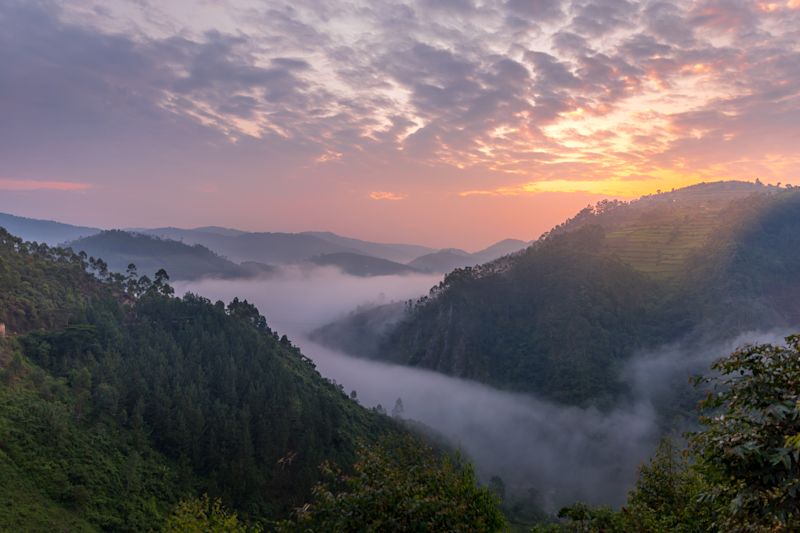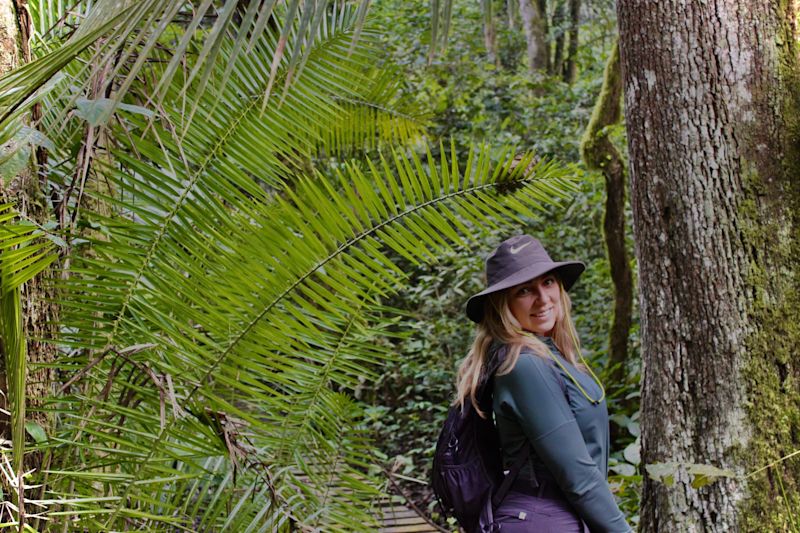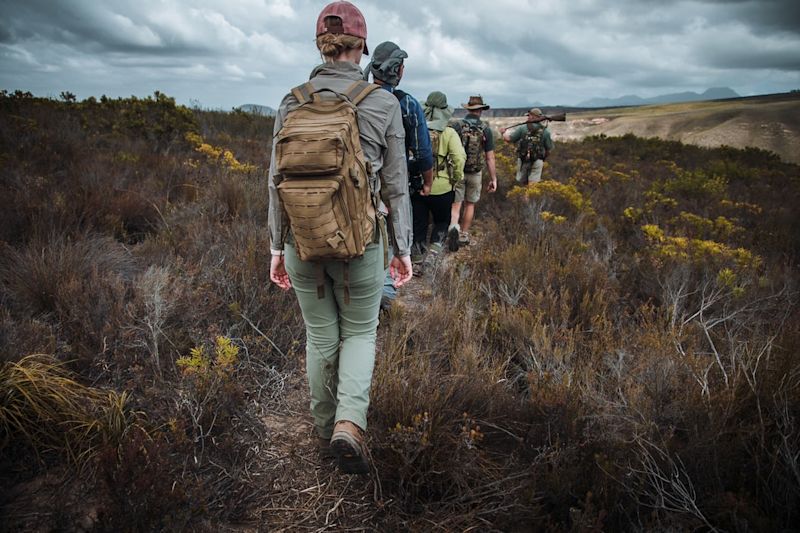Mostly you can't walk in East Africa's big game wildlife reserves. But happily there are a few special places where it's permitted, and is also reasonably safe (provided you stick to the guidelines).
To be able to experience the landscape and wildlife of East Africa from outside of a vehicle is a special treat, and we encourage safari-goers to take hold of these opportunities whenever they can!
Here are the four best types of walking safari, as well as the best (or only) places for doing them.
1. Mountain gorilla trekking
Perhaps the most well-known and exciting walking safari on offer East Africa is mountain gorilla trekking.
Gorilla lives in family groups known as troops
Mountain gorilla trekking is a guided walking safari that takes a small group of visitors deep into the mountainous rainforest where gorillas live. The hikes there and back can last anywhere from an hour to four hours each way. You usually can choose, to a degree, the length and difficulty of your particular hike.
Once you find a troop, you can spend an hour quietly observing them, from how the youngsters play together to their eating and grooming habits.
Gorilla trekking is a truly incredible wildlife experience that attracts animal lovers from around the world.
Trekkers can take a seat and observe these majestic primates up close
It's remarkable that humans can get this close to these endangered animals without stressing them out. And yes, your presence is indeed needed as trekking permits are an important source of conservation funds.
The hike to find a gorilla troop is also an adventure in itself, as you must navigate your way through tangled jungle. There's abundant birdlife to enjoy, beautiful vegetation, and incredible views whenever there's a break in the canopy.
Gorilla trekking can be a muddy business, but it's always super rewarding!
Is it safe?
Yes, gorilla treks are safe, provided of course that you stick to the guidelines given by your trek guide.
You also have a ranger in your group who carries a weapon for just in case. But we've never heard of these being used. This is because mountain gorillas are gentle giants.
A great close-up of an adult gorilla taken by our client Larry
Furthermore, the gorilla troops that tourists are allowed to visit have been slowly habituated to the presence of humans. So it would take a lot to rattle them and cause them to defend themselves.
Gorillas are gentle giants who eat mostly leaves and shoots, as well as some insects.
Mountain gorillas are mostly vegetarians
Where can I go gorilla trekking?
Mountain gorillas live in Rwanda, Uganda and the DRC.
That said, it's only Rwanda and Uganda that are geared towards tourists. Both offer an organised gorilla trekking system with conservation at its heart.
Rwanda's mountain gorilla population lives in Volcanoes National Park
There are just three locations in East Africa offering gorilla treks:
- Bwindi Impenetrable National Park, southwest Uganda – it sells the most permits per day as it has the largest mountain gorilla population.
- Mgahinga National Park, southwest Uganda – it has fewer gorillas and so only sells a few permits per day.
- Volcanoes National Park, northwest Rwanda – this is the easiest park to reach from an international airport.
Uganda's Bwindi Forest with a valley of mist
If you'd like to know more about this exciting walking safari, please read 20 things to know about mountain gorilla trekking. Or if you're ready to book yourself on a trip, please take a look at our exciting Uganda itineraries and Rwanda itineraries, all of which include a gorilla trek.
2. Chimpanzee tracking
The cousin of the gorilla trek is the chimpanzee trek.
Chimpanzee trekking (or chimpanzee tracking) sees you go on a guided half-day hike in a small group to find a troop of Eastern chimps living in the wild. You're allowed to spend an hour in their company, watching them eat, groom, play and in many ways act a bit like humans.
An Eastern chimpanzee spotted in western Uganda
On a chimp trek, you're going to be looking up quite a lot, as chimpanzees spend most of their time in trees. But they do also come down to the ground at times, which offers visitors an even better view of them.
One of the perks of a walking safari to see chimpanzees is that it is much more affordable than mountain gorilla trekking. So even if you break the bank a little on your gorilla trek, you should still be able to afford to add a chimp trek to your itinerary.
An adult chimp spotted in Rwanda
Is chimpanzee tracking safe?
When you go chimpanzee tracking, you visit a troop that's become habituated over time to the presence of humans. This makes them less shy and so you can often stand quite close and quietly observe their fascinating behaviours.
Our client Amber on a chimp trek in Kibale Forest, Uganda
While chimps do in fact have an aggressive side, if you follow the instructions of your guide and refrain from doing anything daft, you're perfectly safe!
Where can I go gorilla trekking?
The best places, in our opinion, for chimpanzee tracking in East Africa are:
- Kibale Forest National Park, western Uganda – this is a beautiful forest hike where you can see plenty of other wildlife along with the chimps.
- Kyambura Gorge, western Uganda – you hike down into the gorge to find chimps, and you should also spot some other wildlife and diverse birds.
- Nyungwe Forest National Park, southwest Rwanda – there are 12 other primates to also try to find in this park, and you have the added benefit of being able to walk a long canopy bridge.
A chimp in Kyambura Gorge
Please note that we offer chimp tracking in Kibale Forest or Nyungwe Forest in most of our Uganda and Rwanda trip packages.
3. Bushwalking
A bushwalking safari is an exciting way to see wildlife while also getting some exercise.
Walking safaris offer another, more intimate perspective of an ecosystem
The bushwalking safari has various advantages over game drives, such as:
- You're more mobile, able to follow the tracks or other signs of wildlife off the main way.
- There's less noise and fumes. This lets you better appreciate all of the myriad sounds of nature, from the rustling of leaves to the songs of birds and chirrups of insects.
- You're more likely to spot some of the more skittish and elusive animals.
- You're able to head into quieter corners of the park and really leave any crowds behind.
- Your guide is able to show and teach you some details they couldn't from a car, such as pointing out spoors (animal tracks) and where animals have impacted tree trunks, and what this tells us.
Hell's Gate National Park in Kenya is full of dramatic scenery
Note that you'll see bushwalking safaris advertised by many camps and parks, but if you look closely these usually take place within the camp's perimeters or outside of the park's boundaries. You'll likely still see fantastic wildlife and have a great time on these bushwalks, but just understand their limitations.
Are bushwalking safaris safe?
Most national parks and reserves in Africa don't allow bushwalking safaris for safety reasons. Even usually docile animals can become dangerous if they feel threatened or cornered. Private reserves often do host walking safaris, but we won't discuss those as they're not within the scope of this blog post.
Lake Manyara National Park sits at the base of the Great Rift Valley
All that said, there are some national parks and reserves in East Africa that permit bushwalking safaris, usually because the biggest threats (like lions and crocodiles) aren't inhabitants. Yet occasionally you can go walking in reserves with the likes of Cape buffaloes and hippos, and these are actually the most dangerous animals if provoked.
For this reason, you're usually only allowed to embark on a bushwalking safari in the company of an armed ranger. It's obviously important to always do as you're told to ensure the firearm never has to be used.
Most walking safaris are led by an armed ranger
Where can I go on a bushwalking safari?
In our opinion, the best places in East Africa for a bushwalking safari are:
- Hell's Gate National Park, central Kenya – this is the only national park in Kenya where you can go on a walking safari. There are various solo hikes of different lengths on offer in this beautiful and game-filled park, including down into the gorge and its various slot canyons. Look for giraffes, zebras and various antelopes, and always give the buffaloes a wide berth.
- Lake Manyara National Park, northern Tanzania – this park at the base of the Great Rift Valley escarpment offers guided bushwalking safaris in a beautiful and varied landscape that's awash with large and exciting game (including all of the Big Five except rhinos). You can walk the forest to find primates and warthogs or stroll along the shore of the vast eponymous lake which is always blanketed in large waterbirds like flamingoes and pelicans.
- Kidepo Valley National Park, northern Uganda – this is the perfect destination for those wanting to see wildlife without the crowds, as it's a remote but pristine park chockfull of big game, including 20 types of predators (like lions, leopards and hyenas) and various primates. Your ranger guide will ensure you spot as much wildlife as possible while also staying safe.
Kidepo Valley in northern Uganda offers excellent walking safaris without the crowds
4. Incredibly scenic safari walks
Many foreigners are unaware of just how varied and beautiful the landscapes of East Africa are. The common perception among the uninitiated is that there's just endless savannah with some rolling hills dotted with acacias.
While there is plenty of this, to be sure, East Africa also boasts enormous mountain ranges and towering volcanic peaks, including the world's tallest free-standing mountain, aka Mt Kilimanjaro!
Empakaai Crater is one of East Africa's most breathtaking walking safari destinations
Then there are also white-sand beaches lapped by pale blue waters, coastal mangroves, sheer red cliffs, vast soda lakes, thick mountain jungles ... you get the idea.
Many of these habitats are home to incredible wildlife, from primates like baboons and chimpanzees to birds like flamingoes and ostriches. So let's talk about some of the most beautiful or dramatic landscapes where you can enjoy a safari walk ...
The volcano peak of Ol Doinyo Lengai presides over Lake Natron
What are the most scenic walking safari destinations?
Apart from the walking safari destinations already discussed above – because many of these are 100% among the most beautiful in East Africa – here are some further locations that let you spot plenty of wildlife while also having showstopper vistas:
- Lake Natron, Tanzania – here you can do an easy safari walk guided by a local Maasai to find large game like giraffes, hyenas, jackals and camels as well as the vast swathe of pink flamingoes that cover the lake's shallows. The backdrop to your walk is incredible: the escarpment of the Great Rift Valley on one side, the volcanic peak of Ol Doinyo Lengai on another, and the mountains of the Gregory Rift on the third. *
- Olmoti and Empakaai Craters, northern Tanzania – an armed guide leads you down through the jungle into the open bowls of each of these beautiful collapsed volcanoes where you can find diverse big game like buffaloes and zebras. An enormous soda lake occupies most of the bowl of Empakaai Crater and so you walk around the shore before making the steep climb back out.
- Ngorongoro Crater rim walk, northern Tanzania – while you can't walk inside the crater, a guided hike through the rainforest that covers its rim rewards you with incredible views of the crater floor far below while also letting you hopefully spot some wildlife (leopards live in the forest) and varied birds.
* For the super fit and adventurous, you can actually do an overnight summit hike of Ol Doinyo Lengai!
A view from the forested rim of Ngorongoro Crater
We hope we've inspired you to remember your walking shoes when you head to East Africa so you can take on one or more of these exciting walking safaris!

























